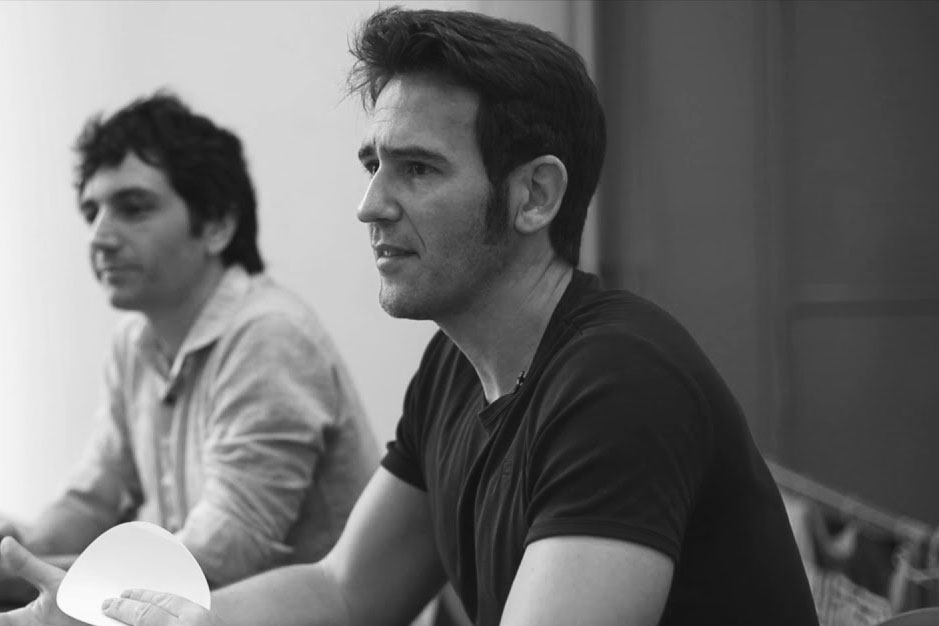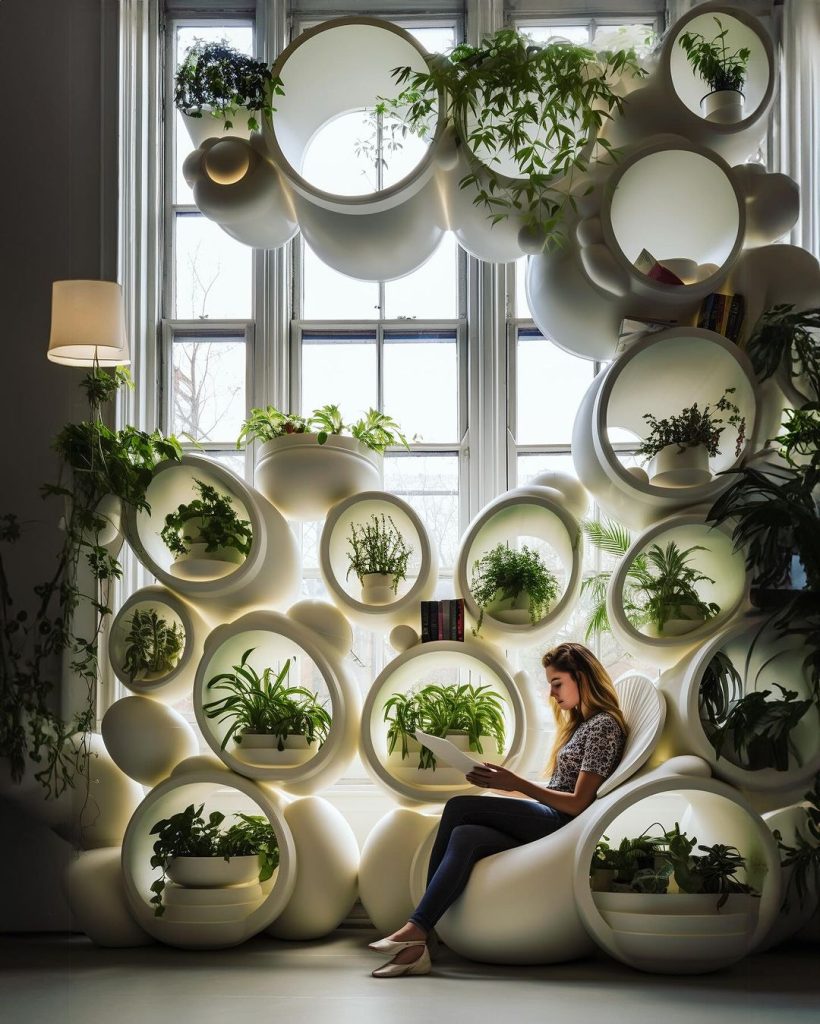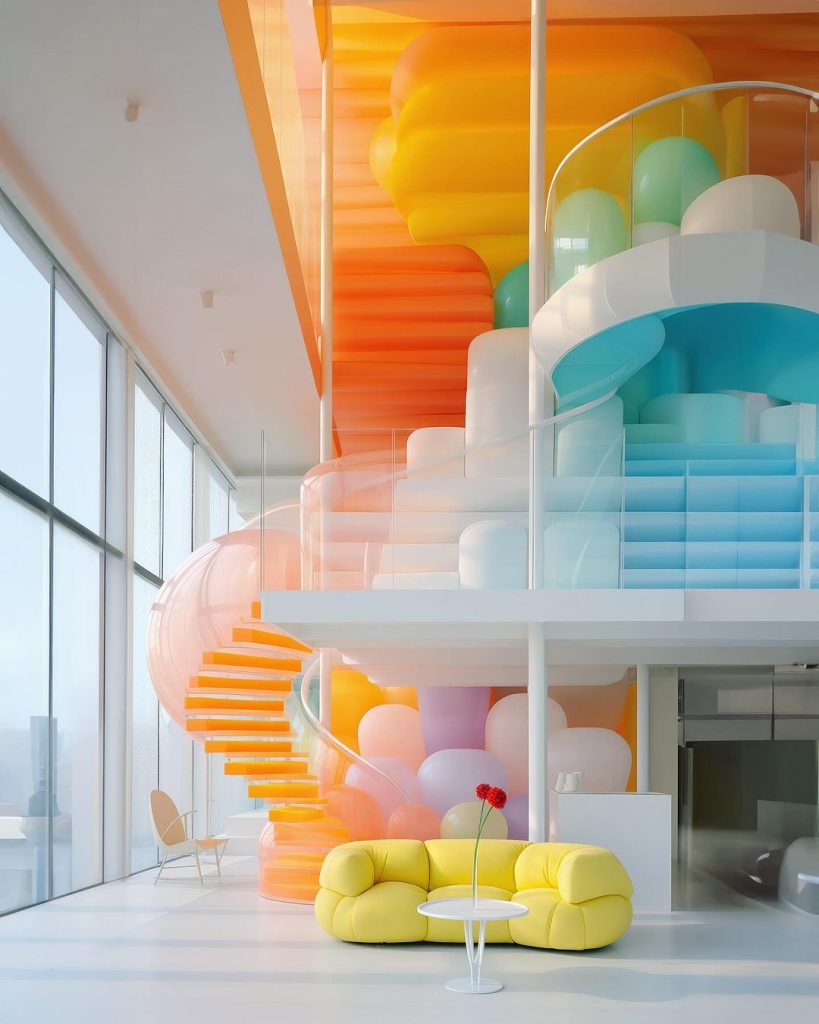During our discussion, Carlos Banon highlighted that Midjourney’s ability to create complex and realistic designs has made it an essential part of his design process. He said, “It has set a benchmark standard in this field due to its unparalleled realism and sophisticated aesthetics. With the current model, almost everything can be created, and I find it stimulating and engaging.” He noted its versatility, allowing him to work on design concepts even while on the move. “It’s my go-to tool whether on a train, a plane, or anywhere else where I want to test ideas. I particularly appreciate how Midjourney articulates spaces, generates hybrid tectonics, and merges styles with a sophisticated sense of elegance.”
Carlos Banon pointed out that while Midjourney has been a game-changer, its rapid adoption has joined the architectural space with similar designs. “However, after just over a year, the prevalence of Midjourney-generated content has led to a saturation of imagery in our visual culture,” Banon said to PA. This saturation has led to a concern that architectural designs’ uniqueness and innovative potential could be compromised. Banon’s observation about workflow creation and integration limitations reflects his keen interest in maintaining a diverse and impactful architectural landscape.
Banon highlighted that his journey didn’t end with Midjourney; he shifted his focus towards platforms like Stable Diffusion that foster collaboration and integration across various design processes. He said, “Stable Diffusion, combined with ControlNet, allows for a rich blend of data sources and software systems to interact, providing a high level of control. This environment enables unique talents like hand sketching, 3D modeling skills, and the creation of entirely new workflows to be augmented by AI to an entirely new dimension.”
Banon’s enthusiasm for converging human creativity and AI innovation was clear. He expressed his excitement about Stable Diffusion’s latest SDXL model, describing it as an exhilarating platform that continuously evolves. He said, “My current focus is finding innovative methods to integrate uniquely human-generated content with AI into buildable designs. I am comfortable navigating the uncertainty of this new hybrid paradigm.”
Carlos Banon’s perspective sheds light on the historical context of technological architectural changes. He said, “Remember the late ’90s when CAD software sparked heated debates in academic circles? Detractors warned that it would drain the artistry from hand-drawing.” He draws parallels between the initial resistance to CAD software and the current advancements in AI tools.
Considering the impact of AI tools on critical thinking and design judgment among young architects, Banon draws parallels to historical technological changes. He recalls the emergence of CAD software and the ensuing debates about its potential to supplant traditional artistic skills.
Banon’s mention of 3D modeling, rendering tools, and parametric design highlights the progression of tools that have continually reshaped architectural practices and capabilities. He continued, “However, CAD not only revolutionized our speed and efficiency; it also democratized architecture by leveling the playing field in high-quality drafting. We’ve seen this pattern play out repeatedly—initial skepticism quickly followed by reluctant yet transformative adoption” and added, Then came 3D modeling and rendering tools like the widely-adopted Maya and 3D Studio, which expanded our capacity for spatial creation and visualization.”
This analogy highlights the need to balance including AI in architectural syllabus and preserving the foundational knowledge communicated with traditional methods. Banon’s role as an educator at the Singapore University of Technology and Design (SUTD), where he teaches AI techniques through the Architectural Intelligence Research Lab (AIRLAB), illustrates his responsibility to prepare students for a future where AI and architectural principles coexist seamlessly.
Carlos Banon reflects on the impact of AI tools on critical thinking and design judgment skills, drawing a parallel with historical technological shifts. He said, “Students now learn differently, using software and tools more intuitively, as aids to thinking, and not just as standalone tools.” He emphasizes the importance of adapting architectural education to incorporate AI techniques while preserving foundational knowledge.
Banon said, “In the end, just as before, we must focus on educating the new generation of students and young professionals on how to appropriately incorporate this new technology in an architectural context. Architectural values have roots in centuries of history, and most of those principles remain relevant.” and added, “AI will supercharge our students with creative power, bringing lots of design alternatives at rapid speeds. However, they need proper training, and this newfound pace and abundance must not supplant our commitment to the foundational principles of architecture.”
He sees AI-generated visuals as powerful sources of inspiration, encouraging architects to break away from traditional rules and explore unexplored design possibilities. “We’re not just following the old rules anymore; we’re making new ones. It’s like we’ve got this whole new playground for our imagination, making the future feel a lot closer to now.”
“In addition to this, AI is set to do more than transform our roles and scopes as architects. It’s going to make our buildings better by helping us understand the complex choices behind a design process.”. This aligns with a sustainable approach to architecture where AI can provide insights to minimize waste and resource consumption throughout the design and construction process.
“In this landscape, our roles as architects will evolve. With AI, we become both creators and discerning curators. Our task evolves into shifting through numerous AI-generated options to identify those that genuinely resonate with our architectural ethos and intuition.” said Banon. This evolution requires architects to balance the abundance of AI-generated options with their architectural sensibilities and judgment. “This is where vision, leadership, and critical thinking are not merely preserved but substantially enhanced. It amplifies the necessity for human expertise in crafting sustainable, impactful built environments.”
He highlights that AI’s influence goes beyond speeding up design processes; it encourages architects to adopt a more investigative and multidisciplinary approach. He said, “ I believe it’s about catalyzing a more investigative, multidisciplinary, and complex approach to designing, increasing even more the level of complexity that we work with while allowing architects to keep a high level of sensitivity and intuition to it.”
“Beyond shaking up design norms, the transformations within the AI paradigm will also redefine how we produce our architectural visions: Digital manufacturing and particularly 3D printing will serve as the vital enabler between our elaborate 3D blueprints and their physical translations.” Additionally, his prediction about democratizing 3D printing through AI highlights the technology’s potential to make advanced manufacturing techniques more accessible to a wider audience.
Banon offers a warning, drawing parallels between the current AI revolution and past technological advancements like NURBS geometries and 3D modeling. He said, “However, history reminds us—be it the initial buzz around NURBS geometries or 3D modeling—that premature euphoria can result in architecturally bold yet flawed designs. These early missteps spawned conundrums – perhaps it is always an unavoidable part of the process – and the produced designs that spectacularly missed the mark on human usability or simply made no sense at all. It was only through the reflective practice of skilled architects that these technologies were meaningfully digested and internalized in our specific domain.”
His critique of AI-generated designs on social media emphasizes the need for a balanced approach. He said, “The proliferation of so-called amateur ‘Midjourney-Architects’ flaunting AI-generated, hyper-realistic sketches is everywhere on social media. Most of these designs miss the basic architectural fundamentals that ground them in relevance, but at the same they might also help us evolve faster into a more assimilated stage where excellence and control leads the way.”
“The architectural employment landscape is heading to a transformative rupture, embodying a classic double-edged sword scenario. On the one hand, I would say that most architects trapped in the quicksand of monotonous tasks—particularly those ensconced in the bigger firms—are walking on precarious ground.” He acknowledges that routine tasks within architecture, especially in larger firms, are susceptible to being automated by AI due to their predictable nature. He continued, “they are prime candidates for replacement by AI, capable of executing predictable assignments with unprecedented speed and zero learning curve.”
In addition, Banon offers a new perspective on the potential impact of AI on the architectural job market. “ Empowered by AI, especially the young architects will find themselves quicker, more incisive, and intrinsically interconnected compared to older generations. I always believed that as architects, we must adapt our workflows and skills to technological shifts, and this unfolding paradigm of human-AI synergy is not an exception.”
His optimistic view focuses on AI as a collaborative partner rather than a replacement, stressing the importance of architects embracing AI’s capabilities.” AI is set to become our invaluable collaborator, our trusted, consistent, and brilliant design partner, and that’s a development we should warmly welcome.” and added, “The architectural realm is undergoing a seismic metamorphosis, but one constant will remain: architects, equipped with the right and up-to-date training and skillset, will continue to serve as the visionary minds designing our increasingly complex world. But this time, hand-in-hand with Artificial Intelligence.”


























Leave a comment